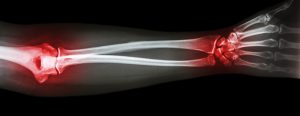Resolving Inflammation Is Key to New Pain Therapies

Research into pain signaling is leading to improved biologic therapies for the treatment of osteoarthritis and other degenerative joint disorders, says Thomas Buchheit, MD, Pain Medicine Division Chief in the Department of Anesthesiology and a member of Duke’s Center for Translational Pain Medicine.
Buchheit says the new treatments fill a therapeutic gap in the management of several painful joint and tendon conditions by identifying and resolving the sources of inflammation.
“We have been relying heavily on steroids, NSAIDS, and opioids for decades despite significant limitations and potential side effects,” Buchheit says. “Following on the heels of rheumatologic advances in RA, ankylosing spondylitis, and inflammatory arthropathies, our nerve injury research is now opening up avenues for biologic treatments in pain medicine.”
Emerging therapies are being guided by discoveries about the links between arthritis, neuropathy, and shared pathologic pathways that lead to chronic pain, and physicians are increasingly recognizing that inflammatory signals are as important as anatomic degeneration in driving the severity of pain for many conditions. Resolution of inflammation using novel approaches, Buchheit says, appears to be critical to improving pain and restoring function.
“I came to this question from a research angle: looking at inflammatory signals in nerve injury in patients who have experienced traumatic amputations,” Buchheit says. “When we study these patients, only half report long-term pain associated with the amputation. The question is why. We need to dig into these signals.”
Disease-modifying antirheumatic drugs (DMARDs) have been studied for use in osteoarthritis but have not demonstrated the efficacy that has been seen in inflammatory arthropathies. However, several other biologically based treatments such as injections of autologous conditioned serum and platelet-rich plasma as well as the use of pro-resolving lipid mediators are showing promise in slowing or improving some of the degenerative changes seen in osteoarthritis.
Disease-modifying and biologic therapies will play a significant role in the future of pain management, Buchheit says. “We need to continue developing these treatments for patients caught in the middle—those who don’t respond well to simple medications, physical therapy, and steroid injections but who are not candidates for arthroplasty or joint replacement surgery.”